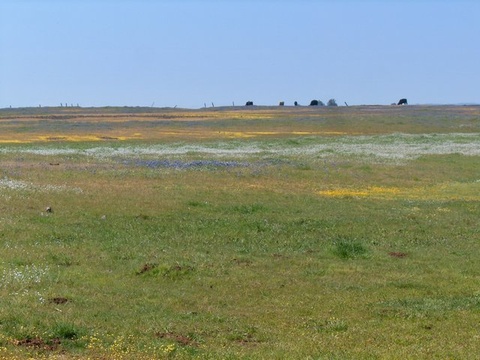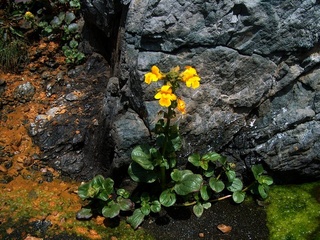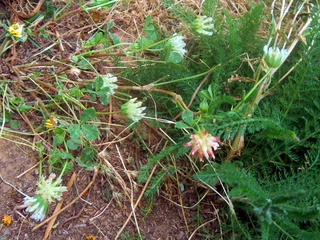 Vernal pools are a seasonal form of freshwater marsh that can be easily recognized in springtime by the characteristic streaks of different-colored flowers blooming in areas where water collected at different depths over the winter, as seen here on Table Mountain. Photo by queerbychoice. Freshwater marsh is the plant community native to areas of Sutter County that have shallow, year-round standing water with no current, including Butte Sink National Wildlife Refuge, Feather River State Wildlife Area, Fremont Weir State Wildlife Area, Gray Lodge State Wildlife Area, and Sutter National Wildlife Refuge. Unlike the riparian forest plant community, which grows on riverbanks, the plants in the freshwater marsh plant community typically grow on flat land that is usually underwater or extremely muddy, with no drainage at all. Trees and shrubs do not survive long in freshwater marsh conditions; they can grow on the edges of deeper lakes or ponds in which there is a bit of current to keep air flowing around their roots, but they rot in the anaerobic conditions of a freshwater marsh.
Vernal pools are a seasonal form of freshwater marsh that can be easily recognized in springtime by the characteristic streaks of different-colored flowers blooming in areas where water collected at different depths over the winter, as seen here on Table Mountain. Photo by queerbychoice. Freshwater marsh is the plant community native to areas of Sutter County that have shallow, year-round standing water with no current, including Butte Sink National Wildlife Refuge, Feather River State Wildlife Area, Fremont Weir State Wildlife Area, Gray Lodge State Wildlife Area, and Sutter National Wildlife Refuge. Unlike the riparian forest plant community, which grows on riverbanks, the plants in the freshwater marsh plant community typically grow on flat land that is usually underwater or extremely muddy, with no drainage at all. Trees and shrubs do not survive long in freshwater marsh conditions; they can grow on the edges of deeper lakes or ponds in which there is a bit of current to keep air flowing around their roots, but they rot in the anaerobic conditions of a freshwater marsh.
A freshwater marsh that dries up completely in summer is called a vernal pool. Vernal pools are more common in the Yuba-Sutter area than year-round freshwater marsh. Perennial plants tend not to survive in vernal pools, because of the widely differing conditions in different seasons. However, vernal pools provide excellent habitat for the many rare annual plants that can also grow in year-round freshwater marshes.
The plants listed below are native to freshwater marsh in Sutter County.1
Herbaceous Perennials
Grasses and Grasslike Plants
True Grasses
Sedges
(See the Sedges page for more information about some of these species.)
Cattails
Forbs
Aster Family
(See the Daisies page for more information about some of these species.)
Water-Plantain Family
broadleaf arrowhead (also called wappato or tule potato)
Other Families
Vernal Pool Annuals
Monocots
Grasses and Grasslike Plants
True Grasses
Rushes
 Toad rush (Juncus bufonius) volunteers in a Marysville back yard in early spring. Photo by queerbychoice. (See the Rushes page for more information about these and other rush species.)
Toad rush (Juncus bufonius) volunteers in a Marysville back yard in early spring. Photo by queerbychoice. (See the Rushes page for more information about these and other rush species.)
twelfth rush (also called inch-high dwarf rush)
Dicots
Aster Family
 Yellowray goldfields (Lasthenia glabrata) in a garden in Marysville. Photo by queerbychoice. (See the Goldfields and Tarweeds pages for more information about some of these species.)
Yellowray goldfields (Lasthenia glabrata) in a garden in Marysville. Photo by queerbychoice. (See the Goldfields and Tarweeds pages for more information about some of these species.)
common woolly marbles (also called short woollyheads)
slender woollyheads (also called slender woolly marbles)
 Common tarweed (Madia elegans) in a garden in Marysville. Photo by queerbychoice.
Common tarweed (Madia elegans) in a garden in Marysville. Photo by queerbychoice.
Borage Family
finebranched popcornflower (also called alkali popcornflower)
stalked popcornflower (also called vernal pool popcornflower)
Bellflower Family
bristled calicoflower (also called doublehorn calicoflower)
folded calicoflower (also called horned calicoflower)
Other Families
 Seep monkeyflower (Mimulus guttatus). Photo by queerbychoice. (See the Clovers and Monkeyflowers pages for more information about some of these species.)
Seep monkeyflower (Mimulus guttatus). Photo by queerbychoice. (See the Clovers and Monkeyflowers pages for more information about some of these species.)
vernal pool paintbrush (also called yellow owl's clover)
yellow seep monkeyflower (also called common large monkeyflower)
common little mousetail (also called tiny mousetail)
needleleaf pincushionplant (also called interwoven pincushionplant)
cowbag clover (also called pale dwarf sack clover) sour clover (also called bull clover)
 The reddish purple flowers of cowbag clover (Trifolium depauperatum) emerge from among invasive, non-native filarees on Table Mountain. Photo by queerbychoice.
The reddish purple flowers of cowbag clover (Trifolium depauperatum) emerge from among invasive, non-native filarees on Table Mountain. Photo by queerbychoice.  Sour clover (Trifolium fucatum) blooms in a garden in Marysville. Photo by queerbychoice.
Sour clover (Trifolium fucatum) blooms in a garden in Marysville. Photo by queerbychoice.
Footnotes
1. CalFlora.org


